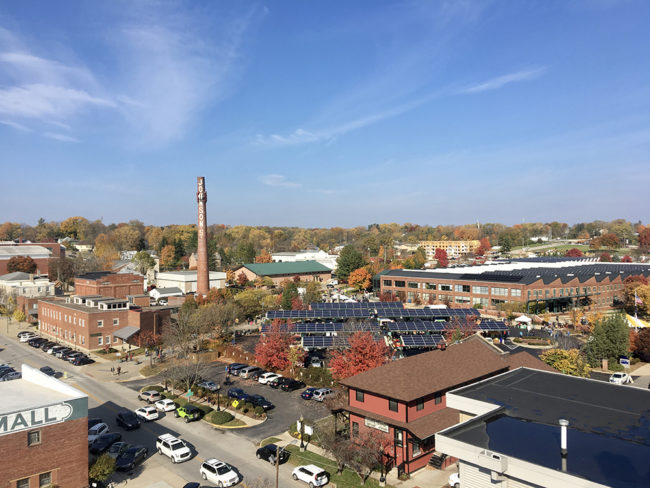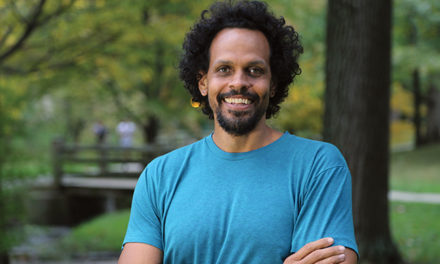
Editor’s note: The following is a press release from CanopyBloomington. Bloom has republished it here with edits for style and clarity.
Six-month old local social impact organization CanopyBloomington has found leadership to facilitate their mission to grow and sustainably manage Bloomington’s urban forest.
CanopyBloomington’s new forestry director, Hannah Gregory, served as the environmental practices coordinator for Indiana University’s Landscape Services and conducted the second comprehensive tree inventory of IU’s campus, which involved mapping and collecting data on more than 12,000 trees. Her subsequent analysis completed with a colleague is actively being used to leverage funding for and to inform tree maintenance routines, priority planting locations, and preferred species lists.
Gregory is also a research associate for the Environmental Resilience Institute’s Urban Green Infrastructure Group, where she assists in processing and analyzing statewide urban tree inventories, including those of the City of Bloomington.
“As the climate changes and threatens to encroach on urban areas across the country, organizations like us are critical in protecting and growing our urban forests and ensuring that tree benefits are equitably spread and are resilient for generations to come,” Gregory says. “It’s evident that Bloomington’s urban forest is decreasing, especially on private land, which is outside of the City of Bloomington’s reach, so I’m eager to begin growing our canopy back in those areas by engaging our community and youth in environmental stewardship.”
Administrative Director Morgan Hicks graduated from the O’Neill School of Public and Environmental Affairs at Indiana University with an M.A. in arts administration in 2021. Hicks honed her business startup, management, budgeting, human resources, communications, and social media skills working with local businesses and organizations, including Janko’s Little Zagreb, Crumbl Cookies, Monroe County History Center, and the Bloomington Creative Glass Center.
“I’m so excited to have an opportunity to contribute to growing and maintaining the tree canopy here in Bloomington. The environmental, health, and social benefits of a robust urban forest are issues that are close to my heart, and I am looking forward to working with the community to ensure that Bloomington is able to provide these benefits to its residents in an equitable and sustainable way,” she says.
On Saturday, October 30, 2021, CanopyBloomington teamed up with the City of Bloomington for a collaborative planting event. CanopyBloomington, Bloomington Urban Forester Erin Hatch, Bluestone Tree, and Trees PLE were joined by volunteers from the community to plant 32 trees in the Matlock Heights neighborhood: 22 in the public right of way and 10 on private property. Weeks before the event, CanopyBloomington reached out to homeowners asking if residents wanted a tree and inviting them to a neighborhood meeting to learn about the tree planting.
Not only did numerous neighbors show up, but Sharon Yarber and Deb Hutton, co-presidents of the Matlock Heights Neighborhood Association, organized neighbors to provide hot cider, bagels, and doughnuts for volunteers. Making up the group of more than 30 volunteers that day were Matlock Heights neighbors, CanopyBloomington board and community members, and IU students, including seven pre-med students involved in the organization Medlife.
Trees are free of charge to homeowners through CanopyBloomington’s organized neighborhood planting days so that income level doesn’t prevent anyone from enjoying the benefits of trees or helping their neighborhood contribute to the overall tree canopy in town. Trees are 1–2 inches in diameter and at least 6 feet tall when planted to give them a solid chance of reaching maturity, when they can best remove pollutants, serve as carbon sinks, manage stormwater, and provide shade and numerous health benefits.
Simon Normile of Bluestone Tree and Seth Inman of Trees PLE started the day by explaining the proper technique for sizing the hole, for positioning the tree, and the correct way to return soil to the hole and add mulch. Most in attendance realized they have been incorrectly mulching trees for years. Neighbors admitted they were surprised to learn how much went into planting a tree properly and many expressed enthusiasm, not just for their new trees but for how much they learned about planting and maintaining them that day.
Each group of three or four volunteers was joined by a certified arborist or urban forest professional who helped make sure the trees were planted properly. To diversify the tree population of the area, ten different species of trees rwere planted. This diversification helps to make the tree canopy more resilient to future threats such as climate change and pests.
Tree planting events such as this are only one way in which CanopyBloomington is hoping to make a lasting impact on the City’s urban forest. With their new leadership and partnerships in the community, the organization has long-range plans to:
- Prioritize planting trees in Bloomington’s marginalized communities.
- Work with the City of Bloomington to plant and prune young trees. Trees need significant care, water, mulch, and pruning their first three years in the ground in order to reach maturity, when they play the biggest role in providing benefits.
- Develop a robust plan of volunteer and paid youth tree tenders as part of a larger professional development program to nurture our newly planted trees.
- Diversify the tree species in Bloomington, so that one pest or disease doesn’t wipe out a large portion of our urban forest.
To donate, volunteer, or learn more about this organization, visit canopybloomington.org/.










